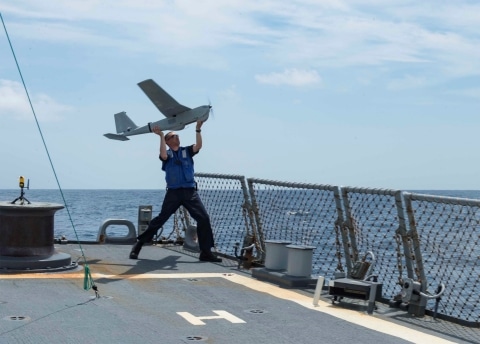Aug 12 2016
AeroVironment, Inc. today announced the United States Navy has tested and deployed the RQ-20B Puma™ small unmanned aircraft system (UAS) aboard a Flight I Guided Missile Destroyer (DDG Class). Some of these exercises included the use of AeroVironment's fully autonomous system to recover the aircraft aboard a ship. The US Navy issued a report on August 3 from the Arabian Gulf describing how Puma AE is also being utilized (see "US Ships Utilize Small Eye in the Sky") on Navy Patrol Craft.
 An operator launches the RQ-20B AeroVironment Puma AE System from the USS Stout during precision recovery system verification flights conducted by the U.S. Navy (Credit: Business Wire)
An operator launches the RQ-20B AeroVironment Puma AE System from the USS Stout during precision recovery system verification flights conducted by the U.S. Navy (Credit: Business Wire)
Following completion of a Puma AE intelligence, surveillance and reconnaissance mission, the AeroVironment Precision Recovery System provides for the autonomous on-board recovery of the aircraft, without interrupting the ship's operations. Because the Puma AE is also designed to land and float in water, operators can choose to recover it from the ocean, should mission requirements dictate.
The AeroVironment Precision Recovery System occupies a small footprint and can be managed and operated by members of a ship's crew, as opposed to requiring external contractors. It is transported in tactical packaging that can be hand-carried aboard and readily transferred from one ship to another.
"Our Precision Recovery System expands the capability of Puma AE to support maritime operations. This solution also builds on AeroVironment's extensive operational experience with small UAS to provide the Navy with a low-cost, hand-launched capability optimized for contested environments," said Kirk Flittie, vice president and general manager of AeroVironment's Unmanned Aircraft Systems business segment. "Puma AE's ability to operate from a wide variety of surface vessels ensures rapid response reconnaissance capabilities that help our customers operate more safely and effectively and proceed with certainty."
Puma AE can be launched and recovered very quickly. The UAS features a gimbaled payload that delivers high quality electro-optical (EO) and infrared (IR) imagery and AeroVironment's secure Digital Data Link (DDL). These features improve situational awareness for the ship and also for boat crews who carry their own remote video terminal ("Pocket DDL") during approach and assist or other missions.
AeroVironment developed the Puma AE system to compete for, and win, a 2008 United States Special Operations Command (USSOCOM) competitive program of record and subsequently supplied the system to the U.S. Navy Expeditionary Combat Command Coastal Riverine Forces, the US Army for convoy and ground troop support and the US Marine Corps. Most recently, the Navy procured Puma AE systems for use aboard Patrol Craft and also deployed them aboard a US Navy Expeditionary Fast Transport (T-EPF) ship in support of counter illicit trafficking operations in the Caribbean. The Puma AE is also employed by several international partners.
The United States Department of Defense recently established the designation RQ-20B for the block 2 Puma AE small UAS. The block 2 Puma AE system includes a more powerful and lighter propulsion system, lighter and stronger airframe, long endurance battery, precision inertial navigation system and an improved user interface. The new, all environment Mantis i45 gimbal sensor suite for Puma AE delivers a dramatic leap in small UAS image resolution and ISR capability and will be available for ordering in September.